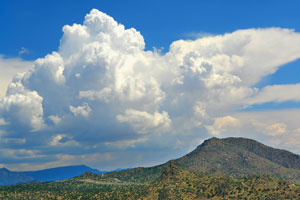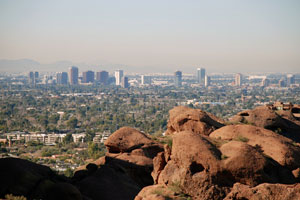Pacific Southwest, Region 9
Serving: Arizona, California, Hawaii, Nevada, Pacific Islands, Tribal Nations
Region 9 Strategic Plan, 2011-14
Air Quality and Climate Change
Healthy air is essential to our day-to-day well-being and long term health. The Clean Air Act (CAA) is the federal law designed to make sure that all Americans have air that is safe to breathe. In the Pacific Southwest, we breathe cleaner air today than we did 40 years ago, despite population growth and increased number of vehicles on the roads. Cleaner air has resulted in fewer illnesses, asthma attacks, hospitalizations and premature deaths. In March 2011, EPA issued a report which looked at the results of the CAA from 1990 to 2020. According to this study, the direct benefits of the CAA are estimated to reach $2 trillion for the year 2020 while preventing 230,000 premature deaths in that year alone.
Despite tremendous progress in reducing air pollution, the Pacific Southwest continues to have some of the worst air quality in the nation with large populations exposed to particulates (PM2.5 and PM10) and smog (ozone). Breathing particulates can cause lung inflammation that can exacerbate diseases like asthma and chronic bronchitis, and can contribute to cardiovascular disease including heart attack and stroke Ozone can cause irritation of the airways and lung inflammation; it can quickly worsen diseases like asthma and lead to hospitalization and even premature death. Air pollution takes a heavy toll on people’s lives and the economy.
Clean air is a national goal. To reach this goal, we work in close collaboration with tribes and 45 state and local air quality agencies.

Region-Wide
- As national air quality standards are updated under the CAA, determine which areas in the Region need to require more pollution controls to come into compliance with federal standards for lead, nitrogen dioxide (NO2), sulfur dioxide (SO2), PM2.5 and ozone, through the creation of non attainment areas. The focus in 2012 will be on designating areas for the new 8-hour ozone and SO2 standards.
- In 2012, review and act on 50 rules developed by state and local air quality agencies to govern air emissions from industrial facilities and determine whether they are sufficiently strong and enforceable.
- The Regional Haze program requires development of air quality plans to reduce the pollution that causes visibility impairments in wilderness areas such as the Grand Canyon, Jarbridge Wilderness Area and Hawaii Volcanoes National Park.
In Arizona
- Determine what controls are necessary for the Four Corners Power Plant, the biggest emitter of nitrogen oxides (NOx) in the country.
- Propose a strategy to control emissions from the Navajo Generating Station power plant.
In Nevada
- Determine the type of controls necessary for Reid Gardner Generating Station by summer 2012.
In Hawaii
- Determine whether controls or alternative fuels are necessary for affected power plants on the islands of Hawaii and Maui by summer 2012.
- Continue to oversee 45 state, local and tribal permitting programs that protect the public from air pollution created by industrial plants. Oversight focus will be on cement plants, refineries, and power plants.
- The Prevention of Significant Deterioration (PSD) program requires that the best available control technology, or BACT, is installed at facilities to control emissions. BACT is an emissions limitation that is based on the maximum degree of control that can be achieved. Since green house gases (GHGs) are regulated under the PSD program, states are required to have provisions for permitting GHGs. We intend to propose approval of the PSD program for the 10 California air agencies that process the highest number of permits. This will result in California’s local agencies being responsible for over 90% of the PSD permitting in California.
- Oversee air modeling and monitoring conducted by state, local and tribal agencies to maintain and enhance the scientific foundation for regulatory actions under the CAA.
- Audit the entire monitoring program for every state and local agency in Region 9 at least once every three years.
- Ensure that state, local, and tribal agencies meet or exceed all monitoring requirements for existing and future air quality standards through regular meetings with technical staff, review of network plans and assessments, data certification, and all other available mechanisms. Focus on air quality monitoring for NO2, SO2, lead, ozone, and PM.
- Implement the Communities Action for a Renewed Environment (CARE) grants in Maywood to identify and prioritize their toxic reduction activities and in Hawaii to reduce illegal dumping activities in four local streams.
- Provide education on implementing the Indoor Air Quality Tools for Schools program at 50 new schools and child care facilities to reduce indoor air pollution. Educate 450 people with asthma, their caregivers and health care professionals on indoor environmental asthma triggers in order to reduce asthma incidents in children.
- Award roughly $45 million in CAA and Diesel Emissions Reductions Act (DERA) grant funds to states, locals, tribes, and other entities to support core air programs such as planning, monitoring, and permitting, and to encourage innovative projects that achieve reductions in air pollution emissions. All grants have work plans and reporting requirements, and the grants are managed to ensure that grant funds are well-spent, and results are achieved.
- Continue developing methods to reallocate continuing air grants (CAA 105) to state and local agencies to better align continuing grants with current conditions, including air quality, population, and state and local air program capacity.
- Take action to ensure all states have adequate infrastructure, through Infrastructure Sate Implementation Plans, to carry out the ozone and PM2.5 provisions of the CAA including permitting programs, resources, monitoring and consultation with the public and/or put in place federal measures where there are deficiencies, via Federal Implementation Plans.
Arizona

Phoenix is situated in a valley surrounded by mountain ranges and also has the largest concentration of industrial sources in the state. The Phoenix metro area is not meeting the coarse particulate pollution (PM10) standard or the current 8-hour ozone standard.
- Improve respiratory health of Arizona residents by reducing unhealthy levels of PM10 to meet the national health based standard by the end of 2012, and begin the process of reducing ozone levels even further.
- Collaborate with state and local agencies in Maricopa County to prepare a new air quality plan that meets the PM10 standard and protects public health. A new plan is due by March 2012.
- Upon redesignation of Pinal County, work with the State to develop plans to reduce PM10 levels. The new plan will require additional controls on sources of PM10 in order to protect public health.
- Conduct federal inspections and investigations in sectors that contribute to elevated PM10 levels in Phoenix, such as sand and gravel facilities and major stationary sources.
California
California’s unique air quality challenge is due to the combination of the state’s weather patterns, topographical formations, rapid population growth, and pollution from vehicles and other mobile sources. The state’s role in Pacific Rim commerce also produces air pollution from aircraft and port operations, which include emissions from ships, cargo handling equipment, trucks, locomotives, and service equipment that are used to distribute imports and goods to the rest of the nation.
Large parts of California exceed the federal health-based standards for both ozone and PM2.5 by a significant margin. The California Air Resources Board estimates that PM2.5 pollution alone is responsible for 9,000 premature deaths annually in California.
San Joaquin Valley:
- Reduce PM2.5 annual concentrations by 7% per year through regulatory action and accelerating the development of cleaner transportation. Achieve a total reduction of 34% from 2009 levels to reach attainment of PM2.5 standards by 2014. The California Air Resources Board (CARB) predicts that640 premature deaths will be avoided per year in San Joaquin Valley if the PM2.5 standards are attained.
- Reduce emissions by working with CARB and the District to develop comprehensive plans for attaining the 2006 PM2.5 standard (35 ug/m3) and the 2008 8-hour ozone standard (0.75 ppm) as early as possible. The PM2.5 plan is due to EPA by December 2012.
- Act on at least 10 San Joaquin Valley rules that will help obtain air emission reductions, including those concerning fumigants, and petroleum production and distribution.
- Convene venture capitalists, government agencies, and private companies in Bakersfield to accelerate the development and adoption of cleaner technology, including medium-duty battery-electric and hybrid trucks and vehicles.
- Manage $400,000 of grant funds that support the development of innovative technology to reduce harmful diesel and PM2.5, NOx and greenhouse gas emissions.
California's South Coast:
- Reduce PM2.5 annual concentrations by 3% by December 2012 through regulatory action and accelerating the development of cleaner transportation and other clean air technologies. Achieve a total reduction of 13% from 2009 levels to reach attainment of the PM2.5 standard by 2014.
- Reduce emissions through regulatory action on the South Coast Air Quality Management District’s rules focused on reducing emissions from sources such as industrial boilers, refineries, coatings, and consumer products.
- Manage $400,000 of grant funds that support the development of innovative technology to reduce harmful diesel and PM2.5, NOx and greenhouse gas emissions.
- Evaluate whether the South Coast air basin has achieved attainment of the current PM10 standard.
- Convene government agencies, private companies and venture capitalists to accelerate the development and adoption of cleaner technology, and site technologies with significant air emission reductions benefits.
Hawaii
- Convene federal, state, city and county governments, non-profits, businesses, and communities to establish a vehicle miles traveled (VMT) baseline and reduce VMTs by 3% by 2013. This VMT effort is part of Hawaii’s Clean Energy Initiative and will support the State’s goal of 70% clean energy by 2030.
- Implement the Rewarding Internships in Sustainable Employment (RISE)
 < Program. RISE is a sustainability internship program providing college students and recent graduates residing in Hawaii with paid green jobs and training. The projects focus on renewable energy, energy efficiency, transportation, water, and waste reduction. By 2013, RISE will leverage resources from EPA and other federal agencies to support one full-time RISE Director, two full-time RISE Mentors, and 20RISE internships on O'ahu and the Big Island.
< Program. RISE is a sustainability internship program providing college students and recent graduates residing in Hawaii with paid green jobs and training. The projects focus on renewable energy, energy efficiency, transportation, water, and waste reduction. By 2013, RISE will leverage resources from EPA and other federal agencies to support one full-time RISE Director, two full-time RISE Mentors, and 20RISE internships on O'ahu and the Big Island. - Recruit and work with at least 7 Hawaii Federal facilities under the federal Green Challenge to reduce their greenhouse gas emissions by 5% by the end of 2013 in at least two of six topic areas: electronics, energy, purchasing, transportation, waste, and water.
Nevada
- Mercury in the air eventually is deposited into water, where it transforms into methyl mercury, a highly toxic form of mercury that can build up in fish tissue. Americans are primarily exposed to mercury by eating contaminated fish. In coordination with the Nevada Department of Environmental Protection, continue implementing the national gold mine Maximum Achievable Control Technology standards for air toxics. The final rule will reduce mercury emissions by 1,460 pounds per year: about a 77% reduction from 2007 levels, nationally.
- In December 2011, we finalized action on the Regional Haze Plan for Nevada, with the exception of the technology to control NOx on the Reid Gardner Generating Station. By end of 2012, we intend to take action on the NOx controls for Reid Gardner Generating Station.
| Pacific Southwest NewsroomPacific Southwest Programs | Grants & FundingUS-Mexico Border | Media CenterCareers | About EPA Region 9 (Pacific Southwest)A-Z Index |
